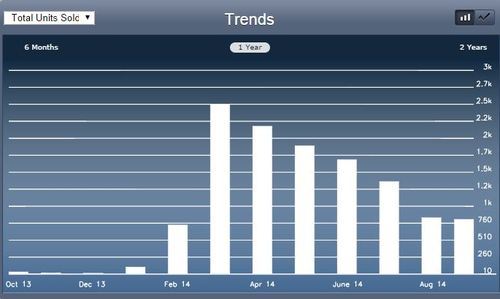Fitwatchr, 1 year later: $26,000 profit and 14,000 users
Oct 17, 2014 · 0 CommentsOne year ago, David Lapekas and I released Fitwatchr, a mobile app that converts Fitbit activity into Weight Watchers points. Following in the footsteps of other indie developers and entrepreneurs that I look up to such as Patrick McKenzie, Nathan Barry, and Pat Flynn, I’m very excited to share our experiences openly.
Humble Beginnings
The idea for Fitwatchr began after I bought a Fitbit device a few months after joining Weight Watchers. I thought it would be useful if I could convert my Fitbit exercise into Weight Watchers activity points. Activity trackers were just starting to take off, and so the more I thought about it, the better the idea sounded. I decided from the beginning to create the app for multiple platforms and decided on a PhoneGap approach. A few months of work during nights and weekends later (my front end skills were iffy at best, so this added time), I had a prototype built. I partnered with Dave to handle all art and marketing efforts.
We launched Fitwatchr in August 2013 on the Google Play store for 99 cents, to much critical acclaim and massive sales. Just kidding - there were just a handful of sales here and there. Having read a lot about app strategies, I started slowly by building an MVP in order to validate the idea and get some initial customers. This worked very well - I charged for the app, people bought it, and I got great initial feedback that was crucial for the eventual success of the app. For the next few months, we polished the app, adding features suggested by users and making sure that the stated goal of the app was rock solid (converting Fitbit activity into points). We didn’t focus very much on marketing; mostly, we worked on improving the app while leveraging social media and Weight Watchers and Fitbit forum boards to drum up interest.
The Turning Point and Sales Breakdowns
Six months after the iOS release (October 2013), sales began to pick up, completely out of nowhere. We had decided on a $2.99 price point after comparing ourselves to other health-related apps and running a bunch of pricing experiments. Towards the end of February 2014, we got 800 sales! I was ecstatic. It didn’t stop there; in fact, March exploded! The two factors that contributed to this where great SEO coming from the Fitwatchr announcement post I wrote as well as finally showing up in search results for “fitbit” on the App Store. The key to this really was that at the time, there were no other Fitbit iPad apps - just ours! Over time, other Fitbit apps appeared and lots of users were confused on the app’s purpose, leading to negative reviews and a steady decline in sales:

We fought the bad reviews as best we could: by improving the app’s usability and adding a customer support website. iOS accounts for nine tenths of our revenue.
In comparison, Android on the Google Play store has had more modest yet stable growth (currently 1,200 lifetime downloads):

Android on the Amazon App Store currently sits at 359 downloads for the year. Not bad, considering there is minimal effort to upload the exact same app package that Google Play gets. It’s an alternative Android marketplace though, so I’m sure it will never quite catch up to Google Play. Since I built Fitwatchr to make cross platform feasibility easy, we eventually put out a Windows Phone version. It’s had only 12 sales so far. This is not surprising as WP has the smallest portion of the market. As for the disparity of sales between iOS and Android, I believe that the cause is twofold: the idea that Android users do not buy apps like iOS users do and our lack of focus on marketing or ads. From what we can tell, word-of-mouth and good reviews are driving steady sales on Android.
Some Thoughts on Profit vs. Effort
It’s possible to see the financials here and get an idea that creating a successful app is easy - frankly, it’s not. As I mentioned above, it started as a passion project on nights and weekends before turning into a serious side gig. While unfortunately we didn’t track hours worked in the early days, I can say that when you compare hours put into the app to the money we earned, we most likely are barely making minimum wage. I’m certainly not complaining, as making any sort of profit is incredible given our world of free and “race to the bottom” app pricing. Also not to discourage anyone from starting out, as I do think app development is absolutely worth it! It’s amazing though the extra stuff you need in order to market and support your app:
- A beautiful website
- Great looking graphics, icons
- Customer Support (contact email at the very least!)
- Ads
- Social Media
Next Steps
It’s been a great ride working on Fitwatchr so far. We’ve learned a ton, helped people lose weight, made a bit of money, and are poised to do even better in 2015. In fact, Upwatchr, our brand new app for Jawbone devices, will be launched the end of the year! In addition to new features, we’re continuing to invest in marketing, ads, and social media as well as bring more apps to market!
One thing is for sure: if we can do it once, we can do it again.
